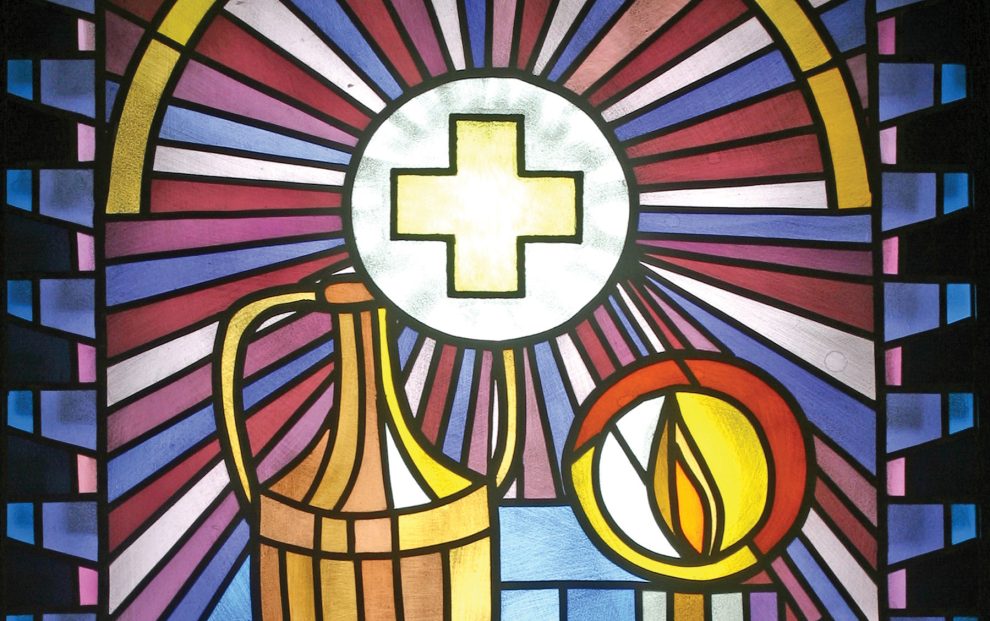My father was seriously ill several times in his last years of life. He could have received the sacrament of the anointing of the sick when facing surgery for a brain tumor discovered when it started compromising his breathing, when the cancer diagnosis turned terminal after several years of relatively stable health, and in the final days before he died. However, due to various circumstances, he was anointed only once as he began hospice care. By that point, he lacked the capacity to communicate much about his experience of the sacrament.
Now, as a teacher of sacramental rites and theology, I ponder how the sacrament of anointing, like all the sacraments, mediates God’s grace and mercy to particular people in specific situations of human life. Anointing proclaims Christ’s presence and the Spirit’s power for and among the sick within a relational and ecclesial context. The theology supporting the current form of the sacrament reflects a broader understanding than in the past about what it means to be sick. It also unambiguously affirms human sickness and suffering undergone by Christians as participation in Christ’s dying and rising—within a perspective encompassing not only eternity but also the present experiences of broken people in this vulnerable world.
Anointing is for people suffering from serious illness
Pastoral Care of the Sick, a liturgical book from the joint commission of bishops’ conferences, notes that anointing baptized people “seriously impaired by sickness or old age” sacramentally manifests Christ’s healing presence and the church’s pastoral care. Regardless of the course an illness takes after anointing, sick people receive spiritual strength from the church’s prayer of faith and oil hallowed by God’s blessing to meet their illness as people who share now in Christ’s suffering and hope to share eventually in the joy of his resurrection. Anointing is certainly appropriate for Charlotte who has cancer, Hector who had a heart attack, Sawyer who suffered a stroke, George wounded by gunshots, and Huy hospitalized after a serious car accident.
However, anointing is also advisable for people suffering from degenerative or chronic diseases that cause serious suffering even if they are not immediately life-threatening—such as Alma, who has Alzheimer’s disease, or Arnold, who struggles daily with crippling arthritis. Anointing is also accessible to people with serious illnesses that remain more hidden because they affect the mind before they ravage the body—people such as Darnell, distressed by major depression; Peter, pained by post-traumatic stress disorder; and Addison, afflicted with addiction. Maria can be anointed before surgery if serious illness prompted the operation. Ernie and Eva, who are elderly, may be anointed “if they have become notably weakened” even in the absence of any particular serious illness.
Anointing a person as death approaches remains recommended, if possible, but there is no need to delay reception of this sacrament until a person who is sick unmistakably becomes a person who is dying. Anointing is a repeatable sacrament! People previously anointed may be anointed again if they recover and then succumb to the same serious illness or a different one, whenever a serious illness enters a significantly more serious phase, or when they are dying. Pastoral and medical discernment about the severity of an illness is advisable, but reasonable judgment suffices.
Anointing is for people called to full, conscious, and active participation in the liturgy—and their lives
The Second Vatican Council continued the process of reframing a sacrament designated during the Middle Ages as “extreme unction” (anointing done near death—in extremis) as a sacrament of healing fittingly celebrated already when a person begins to be endangered by sickness or old age. Sacramental anointing seals the sick person’s status as a dignified member of the human community and the ecclesial community precisely at a time when sickness compromises one’s ability to sustain established community connections, let alone create new ones.
If Susanna is anointed soon after the diagnosis of a serious illness, she herself will participate more actively in the rite (engaging the liturgy’s scripture readings, songs, gestures, actions, responses, etc.). Perhaps she can even provide input to help prepare the rite, shaping its celebration in ways that would make it more meaningful for her. Furthermore, she can invite and enable her relatives, friends, and members of the parish community to participate more actively in this sacramental manifestation of the church’s prayer and care for the sick.
A communal celebration of anointing within Mass or a more abbreviated anointing outside Mass sends the sick forth to continue glorifying God by their lives, despite their illness and weakened position and even through the witness of grappling with their condition. Anointing strengthens baptized Christians to share more fully in Christ’s paschal mystery as they accept the dying and rising of Christ borne now in them, however anxiously or patiently, painfully or precariously, grudgingly or gracefully.
Anointing is for people who long for God’s saving power
Anointing’s “salve” slipped onto the skin of head and hands promises salvation, administering a variant dose of the “medicine of immortality” (a term more commonly designating the Eucharist). When meeting God soon becomes a prominent possibility, people often welcome the sacrament’s calming comfort. “Through this holy anointing,” a priest prays as he anoints a head traced earlier with the sign of the cross in preparation for baptism and perhaps also sealed similarly with this sign in confirmation, “may the Lord in his love and mercy help you with the grace of the Holy Spirit.” Next the priest applies blessed oil to hands that have held and healed, sent and soothed in Christ’s service, saying, “May the Lord who frees you from sin save you and raise you up.”
The sign of the crucified savior who gave his life to lead us to newness of life now marks anew the body of another suffering servant. Any short-term remission of suffering resulting from the sacrament anticipates the ultimate human healing of sharing fully in the life of the risen Christ, the healing that is the hope of Christians. Anointing represents a foretaste of the resurrection in this life for people awaiting its fullness to come.
Anointing is for people who are well
While attesting to the centrality of the paschal mystery in Christian life, anointing compels all baptized Christians to care for the sick according to their capacities to sustain and restore the health of the sick, demonstrate love for the sick, and celebrate the sacraments alongside them. In accepting the sacrament of anointing, even while participating profoundly unconsciously, a dying great-grandfather becomes an embodied witness to the dying and rising of Christ continuing now in Christ’s body, the church—for his family members, the priest, the nursing assistant, and his next-door neighbor.
In this way, the church’s ministry to the sick becomes ministry of the sick. Whether articulated explicitly or expressed implicitly, the sick person’s faith converges with the church’s faith in Christ who suffered and died for us and for our salvation and who now invites us to share more fully in radically redeemed life in light of his resurrection. Despite being very sick or very old, sick people continue contributing to the ongoing mission of the church for the life of the world.
This article also appears in the August 2023 issue of U.S. Catholic (Vol. 88, No. 8, pages 23-25). Click here to subscribe to the magazine.
Image: Shutterstock/Zvonimir Atletic














Add comment